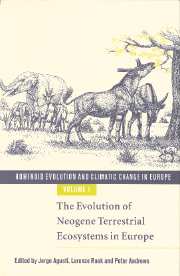Book contents
- Frontmatter
- Contents
- List of contributors
- Acknowledgements: The European Science Foundation
- 1 Introduction
- PART I Palaeogeography of the circum-Mediterranean region
- PART II Miocene mammalian successions
- PART III Palaeoenvironments: non-mammalian evidence
- PART IV Palaeoenvironments: mammalian evidence
- 19 Shrews (Mammalia, Insectivora, Soricidae) as paleoclimatic indicators in the European Neogene
- 20 Mammal turnover and global climate change in the late Miocene terrestrial record of the Vallès-Penedès Basin (NE Spain)
- 21 Palaeoenvironments of late Miocene primate localities in Macedonia, Greece
- 22 The paleoecology of the Pikermian Biome and the savanna myth
- 23 Vicariance biogeography and paleoecology of Eurasian Miocene hominoid primates
- Index
20 - Mammal turnover and global climate change in the late Miocene terrestrial record of the Vallès-Penedès Basin (NE Spain)
from PART IV - Palaeoenvironments: mammalian evidence
Published online by Cambridge University Press: 15 December 2009
- Frontmatter
- Contents
- List of contributors
- Acknowledgements: The European Science Foundation
- 1 Introduction
- PART I Palaeogeography of the circum-Mediterranean region
- PART II Miocene mammalian successions
- PART III Palaeoenvironments: non-mammalian evidence
- PART IV Palaeoenvironments: mammalian evidence
- 19 Shrews (Mammalia, Insectivora, Soricidae) as paleoclimatic indicators in the European Neogene
- 20 Mammal turnover and global climate change in the late Miocene terrestrial record of the Vallès-Penedès Basin (NE Spain)
- 21 Palaeoenvironments of late Miocene primate localities in Macedonia, Greece
- 22 The paleoecology of the Pikermian Biome and the savanna myth
- 23 Vicariance biogeography and paleoecology of Eurasian Miocene hominoid primates
- Index
Summary
Introduction
The global climatic events detected from 12 to 7 Ma include changes in the atmospheric and oceanic circulation, and increasing latitudinal gradients of temperature, starting with the extensive Antarctic glaciation (Miller et al., 1991; Wright et al., 1992; Keller & Barron, 1983) and the beginning of minor glacial processes in the Arctic regions (Zubakov & Borzenkova, 1990). Late Miocene mammal turnovers have often been regarded as being logically induced by this set of changes in the global climate (Steininger et al., 1985; Barry et al., 1985; Meulen & Daams, 1992). This is especially true in the case of hominid evolution, in which extension of dry environmental conditions over large areas of Eurasia and Africa has been regarded as a major feature (Coppens, 1983; Vrba et al., 1997). However, in several cases this is not based on long terrestrial stratigraphic sections with good chronological control but rather on assumed biochronologic correlations not directly supported by an accurate, reliable stratigraphic framework (with the noticeable exception of the work developed in the the Potwar Plateau by the ‘Siwaliks team’; see Barry et al., 1985; Barry & Flynn, 1990; Morgan et al., 1994; Pilbeam et al., 1996). The recently developed magnetostratigraphic and biostratigraphic framework in the Vallès-Penedès Basin (NE Spain) allows, for the first time, a close comparison between the middle–late Miocene mammalian record of Western Mediterranean and Central Asia areas (Figs. 20.1 and 20.2) and its long distance correlation with the global events detected in the oceanic record (Miller et al., 1991; Wright et al., 1992; Flower & Kennett, 1994).
- Type
- Chapter
- Information
- Hominoid Evolution and Climatic Change in Europe , pp. 397 - 412Publisher: Cambridge University PressPrint publication year: 1999
- 13
- Cited by



